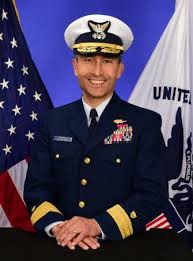Coast Guard’s new acquisition strategy focuses on requirements
The Coast Guard is seeing many of its projects growing into programs of record with acquisition plans and contracts that are both on schedule and on budget thanks...
As other agencies find their projects’ costs and timetables are growing out of control, the Coast Guard is seeing many of its own growing into programs of record with plans that are both on schedule and on budget.
On In Depth with Francis Rose, the Coast Guard’s new Chief Acquisition Officer, Rear Adm. Joe Vojvodich, said that’s because of his new acquisition strategy: focus on requirements now to avoid scope creep later.
“We’re constantly challenged by affordability, were constantly challenged by if we have the right requirements,” Vojvodich said. “Are we producible? Achievable? How are we gaining industry? Those are the kinds of things I can now more pay attention to and make sure we’re advocating and we’re truly on course to achieve that.”
Teamwork is a must
Vojvodich plans on using the requirement-driven strategy he developed while he oversaw the cutter boat program, part of which involves maintaining a connected team.

“You can go back and search archives of lessons learned about why there were cost growths, why things fell apart on the schedules,” Vojvodich said. “There wasn’t a level of commitment from all the stakeholders.”
These changes can already be seen in the Coast Guard’s C4ISR Program through shifts in how fleets are outfitted.
“Ten years ago when we bought the asset, it was very narrowly defined. Each asset program manager got to decide what the radar was, what the radio was, [and] what the C4 system would buy,” Vojvodich said. “We had this disparate, uncommon portfolio that we had to pay attention to.”
Vojvodich said that participation from all departments — from IT to human resources — is key for project success.
“All those folks need to be brought in terms of their requirements in keeping [a project] stable to be able to achieve that program of record in a predictable manner,” he said.
Risk management mitigates potential issues
Vojvodich said planing risk management around growing cybersecurity concerns is also an important part of his strategy.
“The analogy I like to use is you can put enough security on your house that you’re going to lock yourself out. Or you’ve put enough security in and you’re just going to deter the kid around the corner,” he said. “But if someone really wants in and they have the resources, that’s the risk position these conversations need to have as we figure out the security postures of our systems.”
Vojvodich said that as cybersecurity concerns grow, the need to incorporate it into acquisitions grow as well.
“People are saying that could have been me, or that could have been my agency, that could have been my car, my boat, my helicopter, whatever,” he said. “It’s given a little bit more pause, credence credibility when we bring that to the table.”
Change will happen whether you like it or not
While it’s difficult to plan for large scale projects because of issues like technological obsolescence or shifts in priority, Vojvodich said changes are “a fact of life,” and can be worked around.
“Some of that we can forecast, we can predict,” he said. “We have industry to help us understand what that looks like. It just makes it a lot more stable, more predictable.”
Vojvodich used industry to determine what changes needed to be made for changes for current and upcoming cutter boat acquisitions. From 2009 to 2012, Vovjodich asked industry to recommend what components are necessary for cutter boats. The results proved to be a big help.
“We had 1,800 comments in that three-year period, and we drove about half of them into changes,” he said. “By the time we put that into an RFP, in September 2012, it has been stable.”
Work with what you have to make it more affordable
Cost is a major concern for projects. Vojvodich has found ways to keep costs down by working with assets that need minimal upgrades. One example exists in the Coast Guard’s recent acquisition on C-27J cargo planes.
The more than a dozen C-27J cargo planes are being made into mission-ready assets. The C-27Js are already outfitted with weather radar and communications equipment capable of supporting transport and other Coast Guard missions, so future upgrades made by the Coast Guard’s Asset Project Office will include components such as surface search radar and electro-optical/infrared sensors.
The upgrades will make the C-27Js capable of carrying out a full range of Coast Guard missions.
“In the end, I think were going to have a cost avoidance of anywhere in the $500 million-$600 million cost avoidance in terms of an acquisition cost,” Vojvodich said. “We’re going to going to come out ahead of this.”
Copyright © 2025 Federal News Network. All rights reserved. This website is not intended for users located within the European Economic Area.






